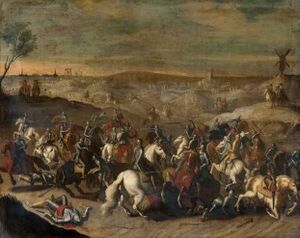Heckel-Cleves War (Pacifica)
| Heckel-Cleves War | |||||||||
|---|---|---|---|---|---|---|---|---|---|
| Part of the Elbonian Wars | |||||||||
 The Battle of Nassoben, the bloodiest battle of the war | |||||||||
| |||||||||
| Belligerents | |||||||||
| Template:Country data Kingdom of Cleves | Template:Country data Kingdom of Heckel | ||||||||
| Commanders and leaders | |||||||||
|
|
| ||||||||
| Strength | |||||||||
|
|
| ||||||||
| Casualties and losses | |||||||||
|
82,000 killed 91,000 wounded 111,000 captured |
78,000 killed 94,500 wounded | ||||||||
The Heckel-Cleves War, known in Heckel as the Elbonian War of Unification, was a conflict between the Elbonian Kingdom of Heckel and the Elbonian Kingdom of Cleves. Lasting from 4 March 1624 to 9 August 1688, the war was caused primarily by Heckel's ambitions of becoming the main Elbonian power, the boiling rivalry between Heckel and Cleves from as early as the 14th century. The war became a part of the much larger Elbonian Wars, and the victory of Heckel paved the way for Elbonian domination from the 17th to 19th century.
Hecklian forces mobilized for war on 1 March, and Clevian forces returned the gesture the following day. Negotiations to end hostilities before war broke out occurred between 2 and 3 March, however historians believe that these negotiations were just a way so that Heckel could prepare further. Hecklian troops started the war by invading Cleves on 4 March 1624.
The war would continue for another 64 years, before finally seeing the end after the disastrous battle of Bissenne on 7 August 1688, which saw the capture of Clevian king Adolp I, alongside 84,000 of his men. Prince Erwin, alongside several of his men, crossed the border into Hohenland on the same day, to prevent themselves being captured by the Hecklian forces. King Adolp was then forced to sign the treaty of Rodenne on 9 August, which marked the end of the war.
The war's impact was one that would define Sugovian history for the next 2 centuries, hailing the period of the Elbonian Wars. The war also saw, for the first time, a unified Elbonian state, under the Hecklian dynasty.
Background
Rivalry between Heckel and Cleves
Hecklian ambitions
Hecklian and Clevian mobilization
Timeline of the war
Invasion into Cleves to the Battle of Upper Aldenborg (1622-1634)
Battle for the Ammel to the Second Battle of Rodenne (1634-1638)
Hosse's campaign to the Battle of Nassoben (1638-1655)
The Seven Years, Coronation of Vilhemm I to the XX (1655-1662)
Placeholder for the rest of the timeline here (1662-1688)
Battle of Bissenne to the Treaty of Rodenne (1688)
Aftermath
Treaty of Rodenne
Elbonian Unification
Elbonian ultimatum to Hohenland
Following the unification of Elbonia, many Clevian loyalists fled in the cover of night to the neighboring kingdom of Hohenland. Many in the Elbonian Empire saw this as an act of aggression and sent an ultimatum to Hohenland. Due to the demands, including allowing Elbonian troops into Hohenlander soil, were too much, the Hohenlander kingdom rejected the ultimatum, starting the Hohenlander War.